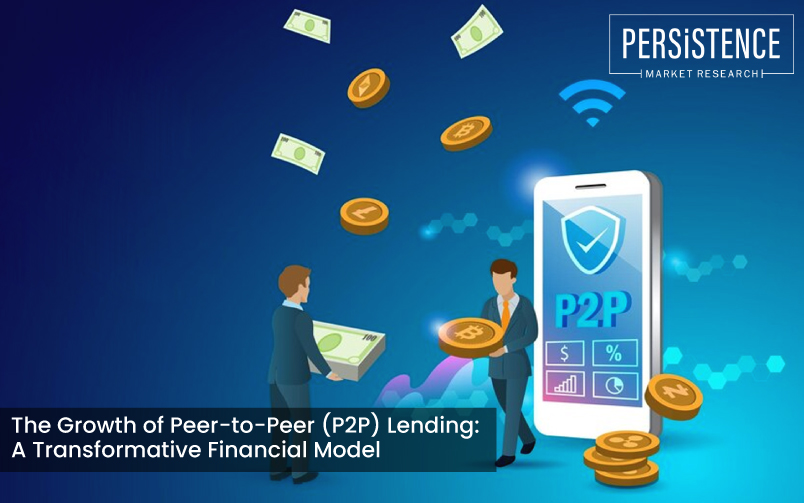The Growth of Peer-to-Peer (P2P) Lending: A Transformative Financial Model
Published On : Oct 03, 2024
Peer-to-peer (P2P) lending has grown into a significant player in the global financial ecosystem, offering an alternative to traditional banking. This innovative model connects borrowers directly with individual investors via online platforms, bypassing conventional financial intermediaries like banks. The rise of P2P lending can be attributed to technology-driven platforms that simplify the process of borrowing and investing, providing more options to both parties.

What Exactly is Peer-to-Peer Lending?
P2P lending is a method where individuals can lend or borrow money directly from one another through a digital marketplace. Unlike banks, which serve as intermediaries between savers and borrowers, P2P platforms allow individual investors to provide loans to borrowers often at competitive rates. These loans are usually unsecured personal loans, meaning they do not require collateral.
Investors benefit from earning a high return on their capital than traditional savings accounts, while borrowers may gain access to credit at better rates than from banks. P2P platforms have two business models such as Direct Disbursal Model and Partner Assisted Disbursal Model as shown in the figure below:
How Peer-to-Peer Lending Works?
Peer-to-peer (P2P) lending connects borrowers directly with individual lenders through online platforms, bypassing traditional banks. Borrowers apply for loans, detailing their financial background and needs. Once approved, their loan requests are listed for potential lenders to review. Lenders can fund the entire loan or contribute portions, spreading risk among multiple investors.
After the loan is fully funded, the platform disburses the funds to the borrower who repays the loan in installments over time. The platform manages repayments and distributes them to lenders. P2P lending offers competitive interest rates and increased accessibility for borrowers while providing investment opportunities for lenders, although risks like borrower defaults should be considered.
What are the Benefits of Peer-to-Peer Lending?
- Lower interest rates for borrowers compared to traditional banks.
- Increased access to credit for individuals and small businesses.
- Potential for higher returns for lenders than traditional investments.
- Opportunity for diversification of investment portfolios for lenders.
- A more direct and efficient lending process that benefits both parties.
- Flexible loan amounts and terms tailored to borrower needs.
- Enhanced transparency in loan terms and borrower information.
- Reduced overhead costs, leading to competitive rates for borrowers.
P2P Lending Becomes More Transparent, Safe and Easy Method
P2P lending has undergone rapid transformation over the past few years. Technological advancements and improved regulatory frameworks have contributed to the growth and security of P2P platforms.
Innovations such as artificial intelligence (AI) and machine learning (ML) are being leveraged to improve credit risk assessments making the platforms safe and efficient for users. Additionally, regulatory bodies in countries like the U.K. and India have started imposing tighter regulations on P2P platforms to ensure transparency and investor protection. These regulations help build trust in the system encouraging people to use these services.
Top Peer-to-Peer Lending Platforms
Globally, several leading platforms have emerged facilitating millions perhaps billions of dollars in loans. Some top platforms include:
- LendingClub (USA): One of the largest and most established P2P platforms in the world. LendingClub offers personal loans and investment opportunities for individuals looking to diversify their portfolios.
- Prosper (USA): Known for its user-friendly platform, Prosper provides personal loans and investment options for users seeking a streamlined borrowing and lending process.
- Funding Circle (UK): Focused on business loans, Funding Circle helps small and medium enterprises (SMEs) gain access to capital that traditional banks might be reluctant to provide.
- Faircent (India): As one of India’s leading P2P platforms, Faircent offers personal, business, and auto loans making it a versatile choice for borrowers and investors alike.
- LenDenClub (India): This Indian platform specializes in small loans for individuals with limited credit access focusing on quick, easy loans with competitive interest rates.
In Conclusion
Peer-to-peer lending revolutionizes the borrowing and lending landscape by offering a more accessible, efficient, and cost-effective alternative to traditional financial institutions. With competitive interest rates for borrowers and attractive returns for lenders, this innovative model fosters financial inclusion and empowers individuals and small businesses.
As P2P platforms continue to evolve and gain popularity, they hold the potential to reshape the future of finance creating opportunities that benefit both borrowers and investors alike.
Procure to Pay (P2P) Solutions Market is Segmented by components such as Integrated Procure to Pay (P2P) Suites, Software includes Purchase Requisition Software, Purchase Order Management Software, Invoicing Management Software, Contract Management Software, Vendor Management Software having services such as Integration and Deployment, Consulting, Support and Maintenance with deployment methods such as Cloud, On-premise
View ReportLatest Reports
-
Medical Implants Market by Product Type (Orthopedic Implants, Stents, Cardiovascular Implants, Stent-related Implants, Structural Cardiac Implants), by Biomaterial Type (Metallic, Ceramic, Polymers, Natural), and Regional Analysis for 2025 - 2032
-
Pet Furniture Market by Type (Pet Sofas & Beds, Pet Houses, Pet Trees, and Others), by Pet Type (Dogs, Cats, Aquatic Pets, Birds, and Others), by Distribution Channel (Supermarkets/Hypermarkets, Specialty Stores, Online), and Regional Analysis for 2025 - 2032
-
Melatonin API Market Source(Natural,Synthetic,Bio-Synthetic), Grade(GMP,Non-GMP), Application (Clinical, Research) and Regional Analysis
-
Low Foam Surfactants Market By Product Type( Non-ionic, Amphoteric, Cationic), By Application(Paper and Pulp, Home and Personal Care, Agrochemicals) and Regional Analysis
-
Retail Logistics Market by Type (Conventional Retail Logistics, E-commerce Retail Logistics), by Mode of Transport (Road, Rail, Air, Water), by Solution (Commerce Enablement, and Others), and Regional Analysis for 2025 - 2032
Procure To Pay P2p Solutions Market
Research Designed to Meet your Specific Needs